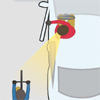Dooring Simulation with Crash Dummy
View dooring dummy demonstration video with explanatory article in German here.
Und wieder mal haarscharf an der Notaufnahme vorbei.
Zum 4. Mal diesen Monat reißt ein junger Autofahrer neben einem gekennzeichneten #Radweg, ohne
Blick im Seitenspiegel & ohne Schulterblick, die Tür plötzlich WEIT auf.
Keine Entschuldigung oder Einsicht!#Dooring-Unfälle #Köln pic.twitter.com/gxOHhIFgSv— Jiji Z (@True_Eyes_) November 30, 2020
Gefahr für Radfahrer und Fußgänger: Parkende Autos und "Dooring", Hürriyet.de, 16.7.2020
1st Study: Validating 'Dutch Reach'
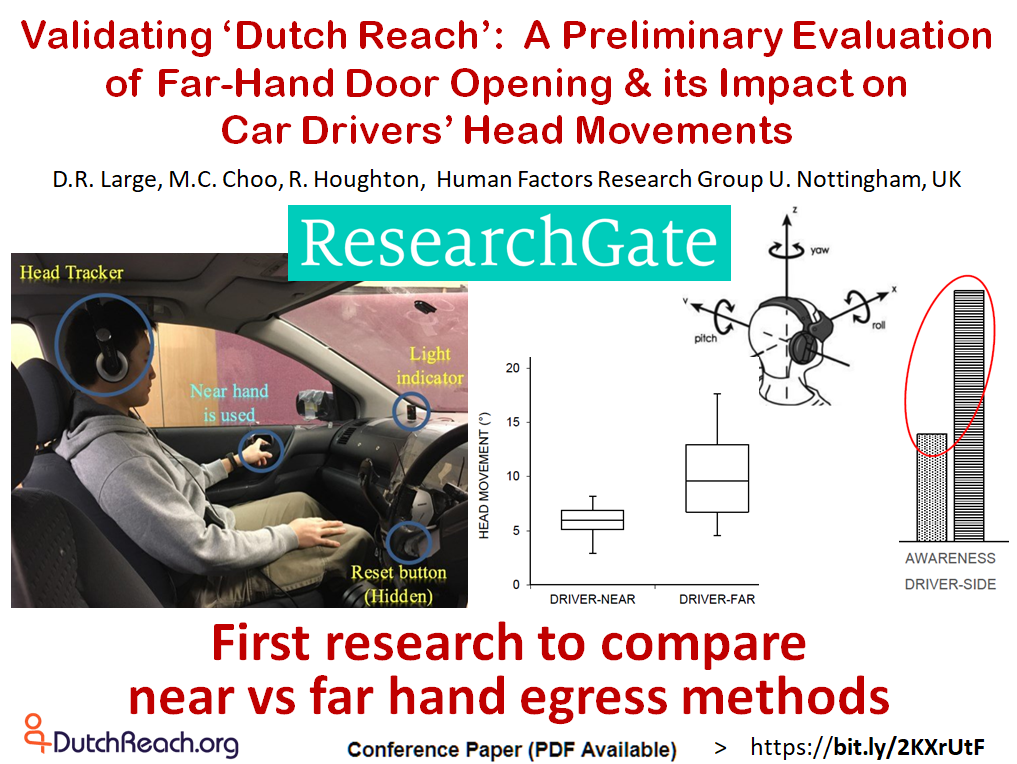
Study finds far hand advantage for Dutch Reach anti dooring method.. See: Validating ‘Dutch Reach’: A Preliminary Evaluation of Far-Hand Door Opening and its Impact on Car Drivers’ Head Movements, Large, DR, et al., Human Factors Research Group, U Nottingham, UK. (PDF). Oct 2018. ICSC 2018 Conference paper. Click image to enlarge.
Crash Data Analysis - Dooring Study
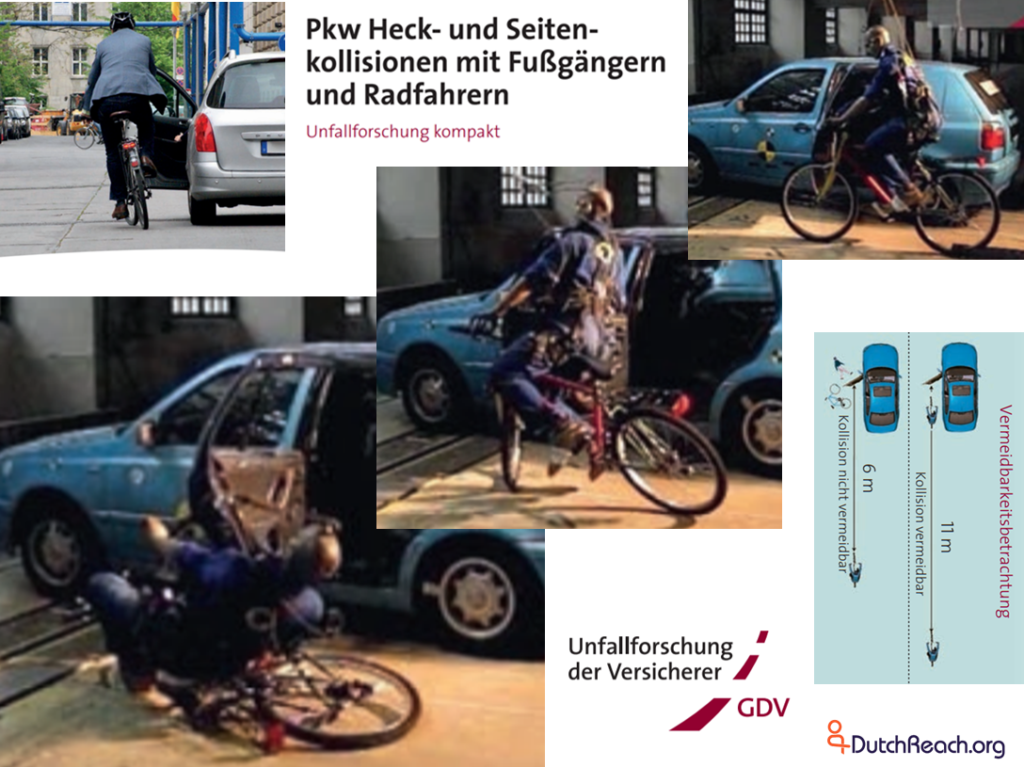
Pkw Heck- und Seitenkollisionen mit Fußgängern und Radfahrern Unfallforschung - kompakt, - Unfallforschung der Verkehrssicher, GDV 2018. PDF download. Research study simulates car dooring scenarios. Results may assist forensic investigations & crashs reconstruction, warning system development & cyclist risk avoidance education.
'Dutch Reach' as Skill Infrastructure
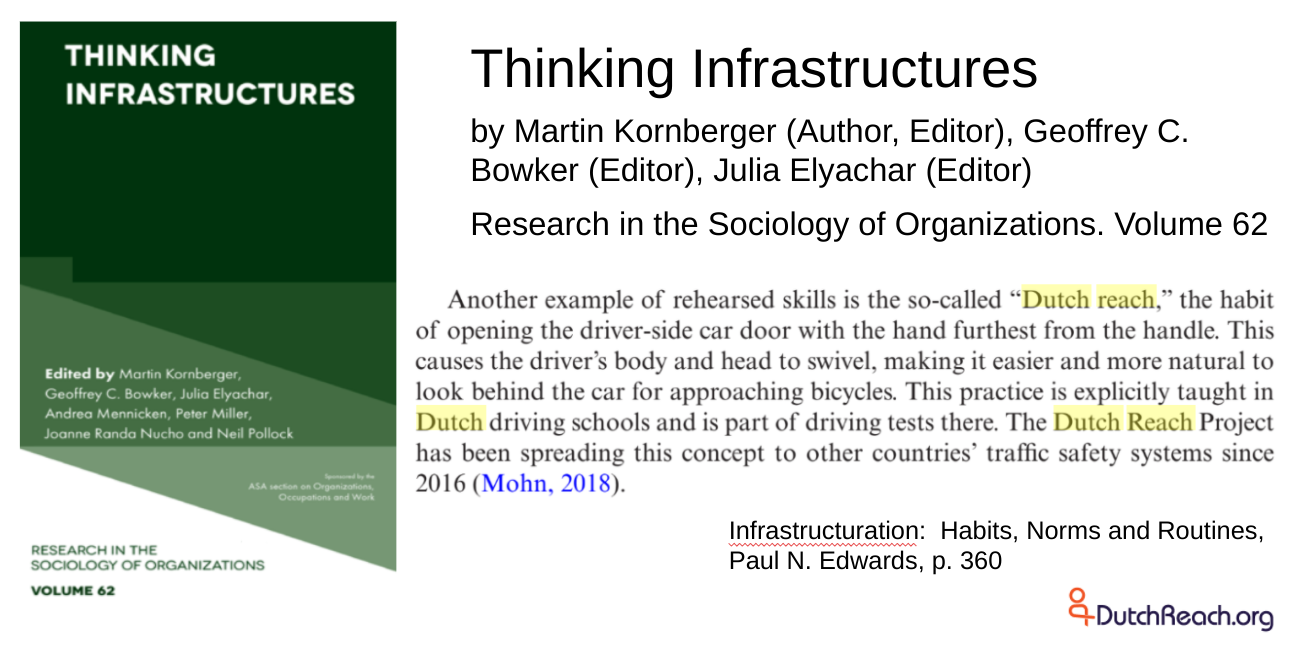
Dutch Reach cited by Paul N. Edwards' chapter: Infrastructuration: Habits, Norms and Routines, p. 360, of Thinking Infrastructures, by Martin Kornberger, Geoffrey C. Bowker, Julia Elyachar, et al., Research in the Sociology of Organizations. Vol 62, Emerald Publishing Ltd, 2019.
Dutch Reach Nudged by Behavioral Scientists
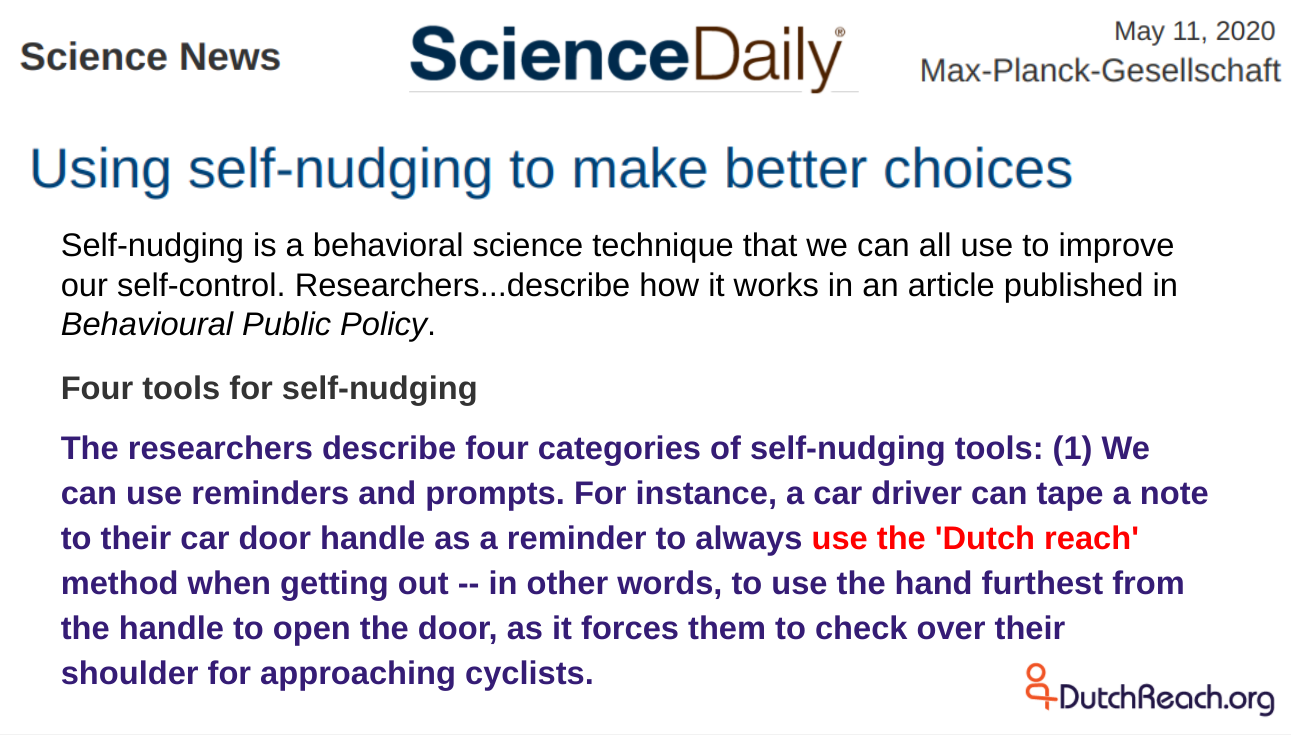
Using self-nudging to make better choices: A behavioral science technique to improve self-control. Max-Planck-Gesellschaft, Science Daily, May 11, 2020. Source: Behavioural Public Policy. Click image to enlarge.
STUDY ON DOORING DANGER NEXT TO PARKED VEHICLES
Cyclists & Open Vehicle Doors - 2013
"Cyclists and open Johnson, Marilyn (2013). "Cyclists and open vehicle doors: Crash characteristics and risk factors". Safety Science. 59: 135–140. vehicle doors: Crash characteristics and risk factors". Safety Science. 59: 135–140.
[Unfunately this is a proprietary journal site so you may need to go through a library or university portal to view it.]
The Conversation published a popular article based on the above research, here:
Want safer cycling? Don't dismiss dooring*
Marilyn Johnson, The Conversation, May 10, 2012.
* from Australia where one drives on the left!
This Video Begs the Question!
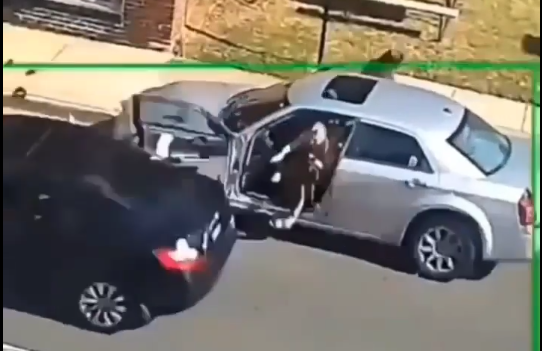
Abrir la puerta del coche "a la holandesa",... evita accidentes !! View video via Twitter/Instagram here
Debatable Case: Did Far Arm Fail or Save? What Happened?
POST IN PROGRESS as DRP attempts to parse rare instance of dooring which may undermine, or may yet support, the claim that the Dutch Reach is safer than the far hand (or foot) push. Meanwhile, your own comments are welcome here.
The adjacent video cam records a dooring collision in which a passing vehicle collides with a partly opened driver side door. The video shows that the exiting parked motorist's far (right) hand was liikely on the door and likely used it - or perhaps also or alone her foot - to push open the door. No further information is available at present beside the cam sequence
The video is noteworthy as it appears to be a rare instance among dooring video cam viewed and gathered by the Dutch Reach Project in which the far hand method was used but a dooring resulted. The significant question from the point of view of the Project is why may the far hand method have failed? Or did it? Was it in fact used without a foot kick or push? Did it include a proper mirrdor check? Was there a delay between rear view and side mirror checks and commencement of opening? Was the door at first nudged open slightly to obtain a clear shouldercheck view back before more fully opening?Did the driver do a shouldercheck at all?
Was the passing vehicle too close to the parked car and or moving too fast or failed to observe an initial door nudge had it occurred? For a nudge could have warned the oncming motorist, though that driver's speed may have prevented a safe deviation of course.
If the exiting motorist failed to do a proper nudged shoulder check scan back and simply pushed the door open, enough to reach 30 degress and perhaps with enough force to have continued opening further by the instant of the collision, then to that degree she bears a futher portion of responsibility.
If the far hand method and all its precautions had been taken, as the oncoming vehicle was moving too fast and drove too close, then more responsibility may be assigned to the second motorist.
Yet if the first motorist only used the far hand and neglected to do mirror checks, neglected to nudge, neglected to do a proper shouolder chekc scan back before more fully opening from 10 or 15 degrees, and thus failed to perform all other parts of the far hand method as advised, EVEN SO the participation of her far hand to open the latch may have save her from seriouis injury as she DID NOT depend on her near hand and was not seen preparing to exit with her back to oncoming traffic., which could have led her, in the last instant, to have stepped blind to the oncoming threat had she done so a split second later.
Observation based on cam recorded sequence of crash.
The cam view is from above, at a downward angle to the street below showing a building with the parallel parked vehcile one and the adjacent travel lane, on a right hand side of road driving jurisdiction. The limited Instagram text is in Spanish.
Description of auto versus auto dooring collision and apparent far hand exiting behavior of driver as she commenced egress maneuver.
A sedan is parked at the side of the road. The driver's door is partially opened, perhaps to a 30 degrees. A shadow is seen on the pavement beneath the door. A white - apparently right arm of the driver is extended to the door. At that moment a seemingly fast moving second sedan drives very close to the parked car, close enough so that it strikes the door, although when edge or face on is not immediately known. But as the collision occurs the exiting motorist's right are is visible just beehind the partly ovened door though the rest of the door is obscured by the passing sedan.
The moving sedan, vehicle 2 now passes out of view. The door of vehicle one is now seen knocked a full 180 degrees forward. Small parts perhaps of the struck door or perhaps of either or both vehicles side view mirror may have been struck off. The entire parked car is jolted and jounces from the impact though it stays nearly in place.
The dirver of vehicle one is now fully exposed as the door is bent against the front hood. Her body is facing outward Her left leg just outside the cabin as if she had prepared to step out perhaps at the very moment the door was struck. Her right arm is visible and still extended. Her previously unseen front seat passenger is iimmediately visible standing having just exited the vehicle, perhaps at the same instant of the collision. She is lookon over the vehicle's roof. Neither occupant appears physically harmed.
The moving vehicle traveled through the frame in well under a second. Indeed the entire sequence shown in vy the video cam is over within 3 seconds from standing start to standing finish.
Questions and Analysis:
Crash Dummy Dooring Video
https://sz.de/1.4968038?jwsource=cl
Gefahr für Radfahrer und Fußgänger: Parkende Autos und "Dooring" [Danger for cyclists and pedestrians: parked cars and "dooring"], Süddeutsche Zeitung, July 15, 2020.
